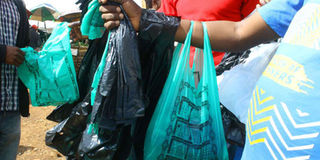Keeping your cool or heat on long safaris

Vendors sell polythene bags in Kisii on April 17, 2017.Now that single-use plastic bags are off the shopping list – and hopefully off the street and out of the environment altogether –there will be an explosion of new designs for multi-use containers: kikapus, kiondos, cardboard cartons and various “carrier bags.” PHOTO | BENSON MOMANYI | NATION MEDIA GROUP
What you need to know:
- The most basic improvement to insulation is to tape the lid seal and wrap the box in a blanket, or piece of carpet or sheepskin.
- The more layers, inside or out, the better (including lining the box, especially the floor, with newspaper, cardboard or polystyrene).
Now that single-use plastic bags are off the shopping list – and hopefully off the street and out of the environment altogether –there will be an explosion of new designs for multi-use containers: kikapus, kiondos, cardboard cartons and various “carrier bags.”
There will be a greater range, technical advances and even added extras. Some will have little wheels (like airline hand-luggage); others will have insulated padding, to keep hot things (samosas?) hot and cold things (ice cream ) cold.
If you want to know the principles of thermal insulation, ask a physics teacher. But if you want to keep food and drink cold (not just for a few minutes while you cross a supermarket carpark, but after a week of motoring in the middle of a desert) you need to ask someone with a bunch of car keys.
The most numerous and frequent users of lightweight plastic boxes known as chilly bins, eskys, coolers and ice chests etc are motorists. They probably account for more than 90 per cent of all cool box sales.
Most just rely on the passive attributes of the insulated box, sometimes pre-loading with ice packs, for getting the shopping home, or for picnics, day trips and perhaps small safaris.
A few more expeditionary types are seriously expert and can keep food and drink below freezing for several days.
And here’s the thing: the most successful long-distance chillers don’t pack any wet ice or dry ice. They pack blankets!
MAXIMISE INSULATION
This seems counter-intuitive to most people, because we feel hotter if we wrap up in a blanket and cooler if we stand in the breeze. That’s because our bodies constantly generate internal heat and we cool down by evaporating sweat.
The contents of your safari cool box are the very opposite. They are a finite store of coldness and nothing will change their temperature – up or down – unless the cold gets out or external warmth gets in.
So the secret is to get the solid contents as cold as possible in a fridge freezer which operates at about minus 32 degrees C (even supplemented by a sprinkling of dry ice at -79 degrees C or lower) before packing in the cool box, and then to maximise insulation that will keep the cold in and the warmth out.
Common cool boxes do offer a level of insulation that is a lot better than nothing, but a lot less than perfect. Making sure the box is packed as full as possible with contents that are as cold as possible, and making sure the lid is tight shut, optimises their built-in properties.
But that can be dramatically improved. Easily. If the contents are as cold as possible, wet ice will not help. It’s only 0 degrees C and when it melts it will make a mess and leave spaces. Dry ice will escape as gas and leave spaces.
The most basic improvement to insulation is to tape the lid seal and wrap the box in a blanket, or piece of carpet or sheepskin. The more layers, inside or out, the better (including lining the box, especially the floor, with newspaper, cardboard or polystyrene). In the car and in camp, keep the box wrapped up, in the shade but out of the breeze.



